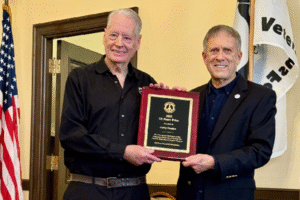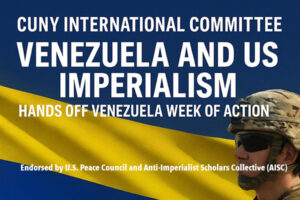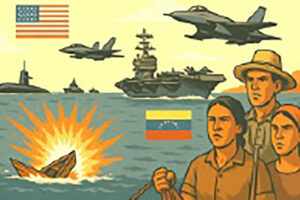The US Peace Council condemns the recent US naval provocation in the waters off South East Asia.
The US public and – even more so, the US antiwar movement – need to understand the larger context of this particular provocation.
On October 27, 2015, the USS Lassen, a guided-missile destroyer, sailed within 12 nautical miles of one of Beijing’s man-made islands in the contested Spratly archipelago. This is the first time since 2012 that the US has directly challenged China’s claims of the island’s territorial limit.
China’s naval commander Admiral Wu Shengli told his US counterpart that a minor incident could spark war in the South China Sea if the United States did not stop its “provocative acts” in the disputed waterway, which is a busy shipping lane, intensively fished, as well as rich in undersea oil.
The US was unapologetic, offering specious arguments that its naval action was based on the international law of the sea, on “freedom of navigation” principles.
More such US provocations in Asia can be expected because this incident was no accident. The provocation reflects a settled US policy, the Pivot to Asia.
President Barack Obama’s 2016 budget for national security is a reflection of the administration’s desire to hold fast to its Asia-Pacific pivot strategy even as newer threats like the rise of the Islamic State and Russia’s aggression in Europe impose new spending demands on various US agencies.
The Obama administration’s $4 trillion budget for 2016 includes $619 billion for a broad set of defense programs and another $54 billion for all the US intelligence agencies to meet both long-term challenges and more immediate threats that have emerged in the last two years.
Underscoring the focus on Asia, Secretary of State John Kerry, in his department’s budget submission, called the pivot to the Asia-Pacific region “a top priority” for every one of us in [Obama’s] administration.
And at the Pentagon, Deputy Defense Secretary Bob Work said the focus on
Asia remains at the top of the military’s five main priorities for the upcoming year. At the top of the list, Work told reporters, are efforts to “continue to rebalance to the Asia-Pacific region.” We continue to do that.
The Obama administration said the Pentagon’s budget is driven by the 2014 Quadrennial Defense Review, a once-in-four-year strategy document that mostly focused American forces toward the Asia-Pacific region while aiding allies in
developing defenses to deal with regional crises on their own. The strategy calls for spending heavily on long-range bombers, new fighter aircraft like the F-35 Joint Strike Fighters, and naval vessels, as well as cybersecurity efforts.”
Against Other Threats, Obama’s Security Budget Sticks to Asia-Pacific Pivot, Gopal Ratnam and Kate Brannen, Foreign Policy magazine, Feb. 2, 2015
The need to “pivot” reflects the constraints on US imperialism. It reflects the relative decline of US power. The former strategic doctrine had been the ability to wage two major wars at once.
When the rebalance toward Asia was officially confirmed as administration policy in January 2012 by the Pentagon’s release of a new strategic policy guidance, (See Pivot to the Pacific? The Obama Administration’s “Rebalancing” Toward Asia, March 28, 2012, Report for Congress Prepared for Members and Committees of Congress, Congressional Research Service 7-5700 www.crs.gov R42448) the underlying impetus was clear: Defense resources could no longer support the long-standing US strategy of maintaining the capability to fight two major conflicts at the same time — the “two-war standard.” (Pivoting Away from Asia, LA Times, Gary Schmitt, Aug. 11, 2014)
Moreover, the “pivot” results from the US realization that its two greatest economic challengers are Russia and China (along with the other BRICS countries – Brazil, India and South Africa). US military policy requires this “pivot” to Asia to directly confront the growing economic power of China. And rather than competing economically, the US prefers to use its military might, which overwhelms the rest of the world by far. And the Obama Administration is trying to “pivot” much of its military actions and positions away from the Middle East, North and East Africa and West Asia.
The US provocation is only the latest example of the Pivot to Asia. By 2012, the Obama Administration concluded the main emerging threat was China. By 2015, the Pivot to Asia is becoming concrete reality, and not just in South East Asia. A few examples:
- A new US military base on the coast of northwest Australia. In early 2015 about 1,150 US Marines began arriving in Darwin Australia as part of the US military’s broader long-term “pivot” to the Asia-Pacific region. Their numbers will rise to 2500.
- US complicity in stirring up rivalry over islands in South China Sea. Before the latest provocation, US had been using its diplomatic influence in favor of Vietnamese claims against China’s.
- US support for Prime Minister Abe’s efforts to revive Japanese militarist feeling, and successful US pressure to weaken or eliminate Article 9 of the 1945
- Japanese peace constitution, which forbids the re-militarization of Japan.
- US cultivation of the conservative Modi government in India – calling for “strategic partnership.”
- The US-initiated Transpacific Partnership, a 12-country “trade “ treaty negotiated by the US, Singapore, Brunei, New Zealand, Chile, Australia, Peru, Vietnam, Malaysia, Mexico, Canada , and Japan. But China, a major trading nation, was deliberately excluded, an economic provocation.
- With US insistence and support, South Korea is building a billion-dollar naval base on Jeju island off South Korea. It is to be completed in 2015.
Not only does the recent naval provocation carry with it the risk of accidental war. It has another more important effect confirmed by vast US experience. In the Cold War, by raising the threat level, by creating NATO, by brinkmanship, by the arms race – the US forced socialist states to divert resources to defense measures and away from peaceful socialist construction. People’s China, already feeling the pressure, has been raising its military budget, although it remains a small fraction of US war spending.
Yet the US is having difficulty extracting itself from its Mideast wars, witness the re- introduction of US grounds troop to Iraq and Afghanistan after much-ballyhooed “drawdowns,” and now the sending of US special forces into Syria.
It is not surprising that the pivot is difficult. By invasion and occupation, by drone bombing, by covert and overt support for jihadism, Bush and Obama have created a vast arc of turmoil, state collapse, and war – from Tunisia and Libya in North Africa stretching through Central Asia to the borders of China, and from the southern border of Turkey to the Horn of Africa. The US and EU states have inflicted war, terrorism, and unspeakable misery on these Middle Eastern and African lands. Now, as a result, a migration of desperate victims to Europe has been set in motion.
The US military provocations on and over the seas of Southeast Asia invokes the imperialistic notion that the interests and security of US supersedes those of every other nation. It is not for the US to pass judgment on a long-standing territorial dispute involving China, Vietnam, the Philippines, Malaysia, Taiwan and Brunei.
Imperialist states such as the US try to resolve territorial disputes by further dividing the interested parties, through bullying, military pressure, threats and even war. Importantly, in this dispute, China and Vietnam are states with a socialist orientation. Progressives around the world hold such states to a higher standard of behavior. We believe such states should resist US maneuvers to reignite nationalist enmity between them. They should take the lead in resolving the dispute either by inclusive negotiations in good faith or by seeking impartial arbitration under UN auspices.
We oppose “pivoting” or “rebalancing.” The only “rebalancing” worthy of the name is not one that shifts US interventions and aggressive wars from the Middle East to East Asia. In our view, “balance” means a completely different US foreign policy – one that ends US interventions and aggression altogether and that curbs the power of the darkest forces in our country: the oil companies, the banks and the military-industrial complex, which together are the taproot of that foreign policy
US imperialism is growing more reckless and brazen. With good reason, observers have referred to the US as “in a state of permanent, global war.” This latest provocation in Asia comes at a time when, urgently, the antiwar movement must focus on the dire war dangers in Syria and Ukraine, where nuclear-armed states confront each other, on ending the wars the US and NATO have ignited, on abolishing NATO, on nuclear disarmament, and on emptying all foreign military bases.
The US and People’s China are nuclear-armed states. Therefore we will have to stretch ourselves to counter this rising threat of war in Asia. Almost certainly, there is more provocation to come.





2 Comments
Comments are closed.